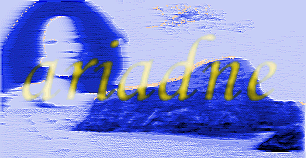 |
 |
|
by Richard Strauss (1864-1949) Libretto by Hugo von Hofmannsthal (1874-1929)  Welcome to my web site, which is dedicated to Richard Strauss's opera, Ariadne auf Naxos. It contains reviews of recordings, a plot synopsis, pages for particular singers and other infomation about the opera, as well as a page of links to other opera sites. Click here for the opera's orchestration Click here for quotations from the opera. The first indication that Strauss and Hofmannsthal were working on Ariadne auf Naxos came in March 1911, when correspondence between the two reveals that they had plans for a piece based on Molière's 1670 play, Le Bourgeois Gentilhomme. The idea was to produce a short opera which would be performed at the end of the play as the entertainment for Monsieur Jourdain's dinner guests. Monsieur Jourdain, who lacks any semblance of taste or cultural sensibility, has decided that to create an entertainment guaranteed to please everybody he will have a harlequinade and a tragic opera seria rolled into one. Consequently, following Ariadne's long and heartfelt lament at her abandonment by Theseus, a band of dancing entertainers appear on the island and attempt to cheer her up with song and dance, reassuring her that there are plenty of other fish in the sea. The contrast between the values of Ariadne and Zerbinetta is emphasised by their voice types and music. Whilst Ariadne is given long-breathed, soaring phrases, Zerbinetta has some of the most difficult music ever written for a high coloratura, culminating in a showpiece aria, Grossmächtige Prinzessin, filled with trills and cadenzas and reaching up to a high F sharp. Hofmannsthal famously described the work as a 'serious trifle', and certainly, as seemed to happen so often with Strauss's operas, the half-hour opera of the original plan ended up about ninety minutes long, as Strauss realised that there was far too much material to fit into a shorter work. When the piece was ready for performance in 1912, it was a rather long and unwieldy hybrid. It was first performed at the Württemburg Court Theatre in Stuttgart on 25 October 1912 with the cast including the star soprano Maria Jeritza as Ariadne, Margarethe Siems as Zerbinetta and Hermann Jadlowker as Bacchus. It received a rather mixed reaction. Those whose interest was primarily drama enjoyed the play but were bored by the opera, whilst those who wanted to hear Strauss's music had to sit through two whole acts of Molière first. Consequently nobody was satisfied. The 1912 version received a few more performances, but did not get the sort of recognition Strauss wanted for it. Four years later, after his completion of the highly contrasting Die Frau ohne Schatten, he returned to Ariadne and set to work on a revision. The primary difference between the 1916 version and the original is that the music is made autonomous from the play by means of a forty-minute prologue. This ingenious piece takes us behind the scenes a few minutes before the performance of Ariadne is due to begin, and Strauss uses it to send up the musical establishment whilst simultaneously making a serious statement about the funding of artistic endeavour, a statement which is probably more relevant to opera today than ever before, particularly in view of Covent Garden's continual (wilful?) failure to make opera accessible to any but the stinking rich. A new character is created, the supposed composer of the opera itself. Sung by a soprano, he has much of the adolescent impetuosity of Octavian from Der Rosenkavalier and Strauss paints a portrait both comical and touching of a temperamental and naîve young man whose artistic ideals are doomed to disillusionment by the people with whom he is forced to work. His ideals are set against a backdrop of bad-tempered argumentative singers, a troupe of light-hearted but earthbound comedians and the philistine values shared by his patron and his staff, all of whom have priorities other than the performance of the composer's tragic opera about human solitude and death. By the end of the prologue the composer has been forced to make cuts in his work and submit to the ultimate horror of having a harlequinade placed in the middle of it. Whilst they make the action almost farcical, Strauss and Hofmannsthal manifest a wryness resulting from experience, and Strauss revels in the irony of a dramatic situation comparable to what happened to his own Ariadne. Various characters quip that by the time the audience have heard the opera they'll be so bored that they won't be able to enjoy the harlequinade that follows it, whilst the dancing master lightly remarks that cutting the opera will present no difficulty at all since it contains so many boring bits As well as the addition to the prologue, Strauss made a few changes to the opera itself. Zerbinetta's aria is cut and transposed down a tone, whilst an entire scene in which she helps the nymphs to prepare Ariadne for Bacchus's arrival on Naxos is cut. Most significant in terms of the opera's overall effect is a change to the ending. In 1912, when Ariadne and Bacchus leave the stage, the comedians return, to have the last say with a reprise of part of Zerbinetta's aria. Finally Monsieur Jourdain (who has been sitting on stage watching the opera throughout and whose guests have all left before the end) expresses his belief that he would love to be aristocratic so that he could behave rudely and appear refined. In 1916 the opera ends with an ecstatic climax to the love duet between Ariadne and Bacchus and there is no bathetic change in atmosphere. This ending, undoubtedly beautiful, leaves us completely divorced from the world of the prologue which now seems a lifetime ago. The revised version received its first performance on 4 October 1916, the cast including Maria Jeritza again, with Selma Kurz as Zerbinetta and Lotte Lehmann in the new role of the composer. This time the opera was a success, achieving instant stardom for Lehmann, and it is in this form that the opera has secured its place in the canon. Strauss always preferred the earlier version, and artistically it is perhaps better rounded, drawing the varied strands of the evening together at its close. It also has the exhilarating experience of Zerbinetta's longer, higher, more difficult aria (supposing anybody can be found who can actually sing it), but the newer version is far more practical to perform and has Strauss's witty and entertaining prologue. Without it, to modern audiences, the opera just doesn't seem complete. Sign Guestbook View Guestbook Number of visitors to this site:  |